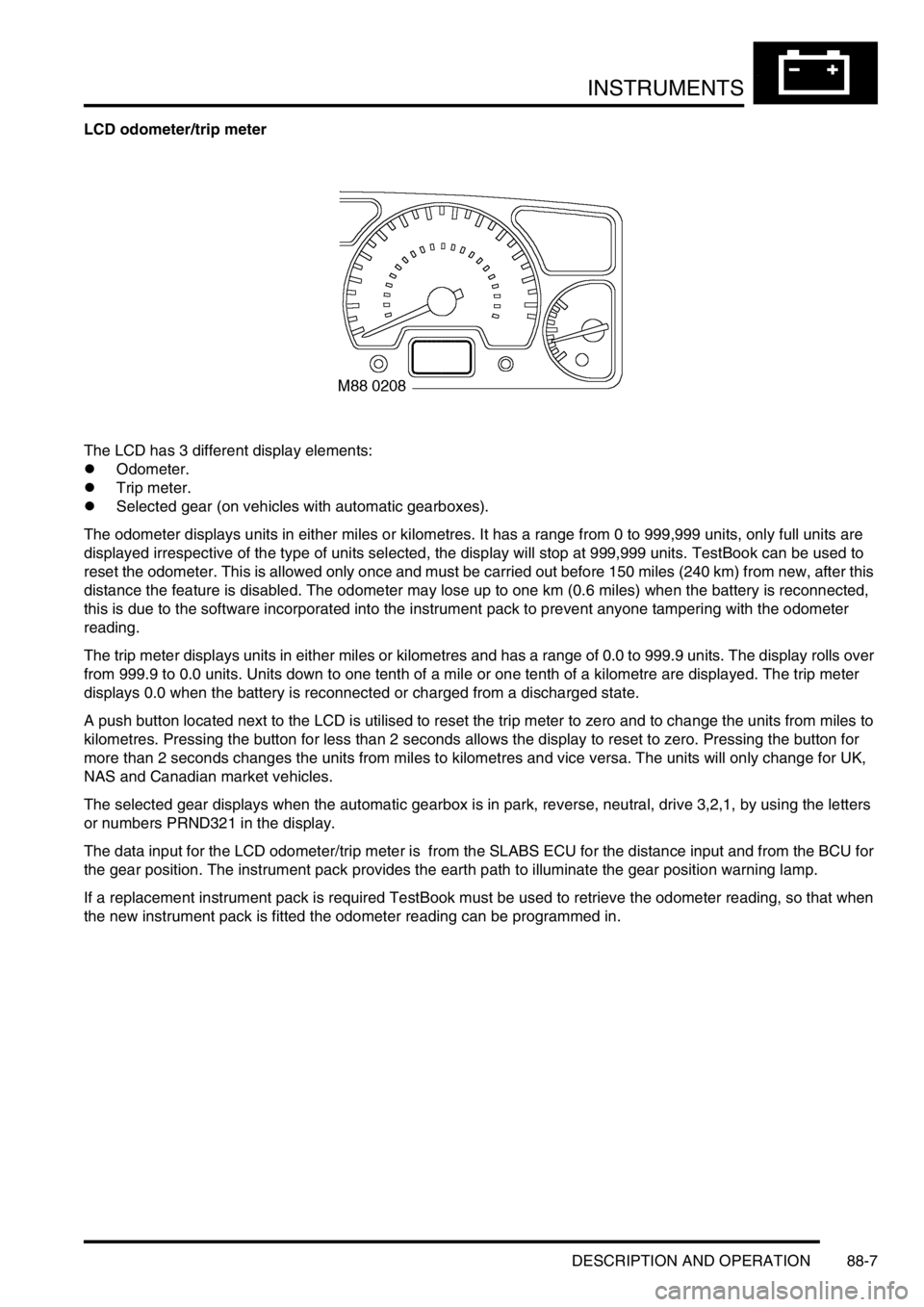2002 LAND ROVER DISCOVERY reset
[x] Cancel search: resetPage 1632 of 1672

INSTRUMENTS
DESCRIPTION AND OPERATION 88-5
Description
General
The instrument pack consists of four analogue dials, four warning lamp packs and a Liquid Crystal Display (LCD)
odometer.
The four dials are used to indicate:
lRoad speed.
lEngine speed.
lFuel tank level.
lEngine coolant temperature.
The dials are driven by a microprocessor from information received from the serial communication link. Information
input is received as either:
lDigital.
lAnalogue.
lPulse train.
lPulse Width Modulation (PWM).
The LCD provides information for:
lOdometer.
lTrip distance.
lSelected gear (on vehicles fitted with an automatic gearbox).
A trip reset button is provided to zero the trip display, this button also allows the selection of "miles" or "kilometres"
for the display. A photocell controls the illumination of the LCD, maintaining contrast of the display during ambient light
changes.
Within the four warning lamp packs there are 28 lamps. A long life bulb illuminates the high beam warning lamp and
the rest of the warning lamps are illuminated by Light Emitting Diodes (LED's). All warning lamp legends are invisible
until lit. When lit the symbols are illuminated on a black background.
The warning lamps illuminate in one of four colours. The colour indicates the level of importance to the driver, as
follows:
lRed = warning.
lAmber = caution.
lGreen = system operative.
lBlue = main beam operative.
The first warning lamp pack is located in the top left-hand side of the instrument pack and contains the following
warning lamps:
lTraction control warning lamp.
lTransfer box in neutral warning lamp.
lDifferential lock warning lamp
lOverspeed warning lamp (activated for gulf market only).
lBrake system warning lamp.
lHill Descent Control (HDC) information warning lamp.
lMalfunction Indicator Lamp (MIL)/ SERVICE ENGINE SOON warning lamp.
The second warning lamp pack is located in the centre of the instrument pack and contains the following warning
lamps:
lDirection indicator warning lamps.
lHigh beam warning lamp.
lAnti-lock brake system warning lamp.
Page 1634 of 1672

INSTRUMENTS
DESCRIPTION AND OPERATION 88-7
LCD odometer/trip meter
The LCD has 3 different display elements:
lOdometer.
lTrip meter.
lSelected gear (on vehicles with automatic gearboxes).
The odometer displays units in either miles or kilometres. It has a range from 0 to 999,999 units, only full units are
displayed irrespective of the type of units selected, the display will stop at 999,999 units. TestBook can be used to
reset the odometer. This is allowed only once and must be carried out before 150 miles (240 km) from new, after this
distance the feature is disabled. The odometer may lose up to one km (0.6 miles) when the battery is reconnected,
this is due to the software incorporated into the instrument pack to prevent anyone tampering with the odometer
reading.
The trip meter displays units in either miles or kilometres and has a range of 0.0 to 999.9 units. The display rolls over
from 999.9 to 0.0 units. Units down to one tenth of a mile or one tenth of a kilometre are displayed. The trip meter
displays 0.0 when the battery is reconnected or charged from a discharged state.
A push button located next to the LCD is utilised to reset the trip meter to zero and to change the units from miles to
kilometres. Pressing the button for less than 2 seconds allows the display to reset to zero. Pressing the button for
more than 2 seconds changes the units from miles to kilometres and vice versa. The units will only change for UK,
NAS and Canadian market vehicles.
The selected gear displays when the automatic gearbox is in park, reverse, neutral, drive 3,2,1, by using the letters
or numbers PRND321 in the display.
The data input for the LCD odometer/trip meter is from the SLABS ECU for the distance input and from the BCU for
the gear position. The instrument pack provides the earth path to illuminate the gear position warning lamp.
If a replacement instrument pack is required TestBook must be used to retrieve the odometer reading, so that when
the new instrument pack is fitted the odometer reading can be programmed in.
Page 1668 of 1672

INSTRUMENTS
DESCRIPTION AND OPERATION 88-41
Diagnostic connector
RHD illustrated
The diagnostic connector allows TestBook to communicate with the vehicle electrical system.
The modules that TestBook can interface with via the diagnostic connector are:
lSLABS ECU.
lBCU.
lECM (V8 and Td5).
lIDM.
lACE ECU.
lEAT ECU.
lSRS DCU.
TestBook communicates with the ECM, ECU's and the instrument pack for diagnostic purposes and for configuration
for a specific options or market. If communications on the diagnostic connector fail for greater than three seconds after
the ignition is in position II the gear selected display in the LCD flashes. This applies to both manual and automatic
vehicles in all markets.
The instrument pack options configured by TestBook are:
lAutomatic or manual gearbox fitted.
lDiesel or V8 engine fitted.
lACE fitted.
lSLS fitted.
lGulf, Japan or ROW markets.
lService engine reset.
lOdometer reset.
lHDC fitted.
lTraction control fitted.
The serial communications link is a bi-directional communications network providing both input and output on the
same pin.
M86 4705
Page 1670 of 1672

INSTRUMENTS
DESCRIPTION AND OPERATION 88-43
Compass
The mirror's compass display is activated when the ignition switch is turned to position 'II'. If the compass has been
previously calibrated, the current direction of the vehicle will be shown in the LED display at the upper RH side of the
mirror's reflective surface. The display is able to indicate one of eight compass points (i.e. N, NE, E, SE, S, SW, W or
NW).
The compass mirror circuit board contains a microchip which is able to determine changes in vehicle direction due to
the changes in the earth's magnetic field. The circuit board is located in the stem of the mirror so that it follows the
changes in the vehicles direction and is not affected by adjustment of the mirror itself.
Because of changes in the lines of magnetic influence, the compass is set for operation in one of fifteen different zones
depending on the current location of the vehicle. If the vehicle is to be driven in a different zone, the compass will have
to be reset for operation in that zone. To determine the correct zone for a particular location on the planet, refer
to the maps provided in the Owner's Handbook. The mirror's default setting is zone 8 which is suitable for central
European countries (Germany, Austria, Italy etc.).
The compass should be set to the correct zone using the following procedure:
1Switch the ignition to position 'II'.
aIf the compass displays one of the eight compass point directions, proceed to step '3'.
bIf the compass displays 'C' then proceed to step '2'.
cIf the display does not show either of the above, then the calibration button on the underside of the mirror
should be pressed and held for approximately 6 seconds, using a small probe (e.g. paper clip or ballpoint
pen). The compass should now enter the set mode and 'C' should be shown in the display.
2To calibrate the compass, the vehicle must be driven slowly (5 mph (8 km/h) or less) in a circle until the display
shows a direction (usually 1 or 2 revolutions). The mirror can calibrate itself during normal driving, but this will
take considerably longer.
3Set the compass to the relevant zone of magnetic influence by pressing the calibration button on the underside
of the mirror for approximately 3 seconds, using a small probe, until a number is shown in the display. If the zone
is being entered for the first time, the default zone setting '8' should be displayed. If the zone is being reset from
a previous entry, the previous zone setting number will be displayed.
The calibration button should now be pressed and released with single presses, using a small probe, until the
desired zone number appears in the display.
After approximately 10 seconds, the compass display should return correctly set to the required zone.
Note the degree of magnetic variation from one zone to another is only very slight. Recalibration of the compass is
not normally necessary unless several zone changes are undertaken.
Automatic dimming
The mirror's automatic dimming function operates when the ignition switch is turned to the 'II' position.
A light sensor is contained at the upper centre of the mirror which detects the intensity of light from the headlights of
following vehicles in dark or low light conditions. When the light intensity is sufficiently high, the mirror automatically
adjusts the brightness of the reflected light by photochromatically changing the mirror's reflective properties and so
preventing glare affecting the driver.
When reverse gear is selected, the power supply for the mirror's photochromatic function is opened so that the mirror
defaults to its normal reflective properties while the reversing operation is in progress.
Another light sensor is located on the rear of the mirror so that the unit can detect the difference between strong
ambient light and that attributable to following vehicle headlights. To check operation of the light dimming function of
the mirror, use the following procedure:
1Turn ignition switch to position 'II', and ensure reverse gear is not selected.
2Cover the sensor on the back of the mirror.
3Shine a bright light on the front (reflective side) of the mirror; the mirror should darken.